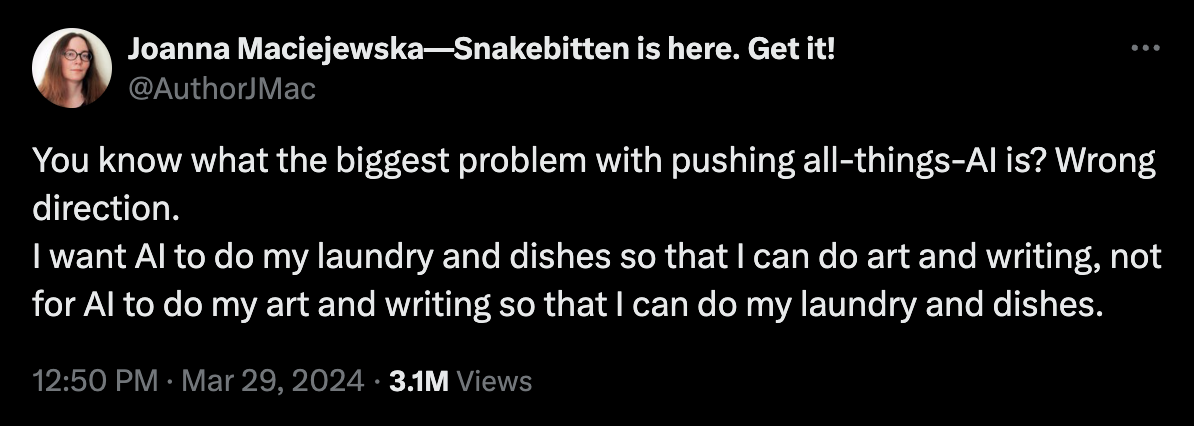Ever since I can remember, I’ve been fascinated by the art of homemaking. Growing up with seven aunts who were skilled in creating warm and loving living spaces, I developed a deep appreciation for the labor and care that turn a house into a home. Though often perceived as mundane, domestic environments are the backbone of our lives, and making them special is both an art and a hard-earned skill. Little did I know that this appreciation for the everyday would lead me to explore the intersection of domestic environments and artificial intelligence.
The Overlooked Power of Everyday Innovations
Let’s start with a list of inventions we can all agree on that make our everyday life significantly better: automatic dishwashers, windshield wipers, coffee filters, fridges, toasters, waterproof diapers (for the parents at least), and home security systems. What do they all have in common? These impactful inventions, integral to our daily lives, were created by women like Josephine Cochrane, Mary Anderson, Melitta Bentz, Florence Parpart, Sarah Guppy, Marion Donovan, and Marie Van Brittan Brown.
The impact of these inventions on our daily lives is immeasurable. However, many people might think that they aren’t particularly creative or that they are “boring.” This sentiment was even described in a study that debunked the unfair myth that men are more creative than women and rather found different characteristics of creativity. Women prioritize the community over the individual and develop useful ideas targeting the need of an audience.
Balancing User- and Tech-Centric Innovation
Similarly, I’ve also often seen a tension between innovation driven by the desire to focus on user problems vs on pushing the technological limitations. My focus on user-centric innovation in domestic environments even got me this comment from a professor: “Why do you spend your time on such boring, mundane stuff if you could work on interesting areas like AR or VR?”
Ironically enough, after spending 7+ years doing research in the domestic space from embedding tech into a kitchen counter to support cooking (check out PersonalChef) and making smart home configurations more accessible for the entire family through a calendar interface (check out Casalendar) I ended up in the AR/VR space for a while.
In the Holoportation project, the innovation was driven much more by the technological advances in computer vision and graphics. My role shifted more to thinking about different scenarios in which the advances of such technologies would shine and demonstrate their unique benefits. Quite a different focus than my previous credo of “Focus on the user and all else will follow.” (from Google’s philosophies) But identifying the unique capabilities of emerging technologies and how they could be modified to fit into everyday life can spark original user experiences. While nothing will ever get me to stop thinking about the user and their needs, it helped me to better utilize aspects of focusing on pushing technical capabilities.
This more balanced approach led to the creation of the first prototype for Playlist Stories at Spotify which ultimately, and only through a massive product and business effort, evolved into AI DJ. I noticed the suddenly very fast-paced improvements of synthetic voices and how it made the idea of natural and high-quality voices with very little data or compute realistic in the mid-term. I learned from my colleague Morteza Behrooz about the trends in interactive narration and saw how our research department was diving into transformer research and how to understand and generate natural language. Putting all of those tech trends together, plus seeing user needs in audio-only listening experiences on voice assistants it became clear to me that there is an opportunity. And that at the very least we should explore how injecting generated personalized audio content in these listening experiences could make for a novel differentiating experience.
Mundane AI?
Now, some rapid developments are happening again. On a daily basis, there is news on what AI can do, even my very-much early adopter, deeply technical friends are overwhelmed trying to catch up with those developments. But it also seems like they are heavily skewed on the technical innovation creating a gap when it comes to simple, smooth, useful experiences and interfaces in our everyday lives. And for my aunts, there hasn’t been much tangible benefit in their everyday life either.
This Tweet (X post?) has been shared with me several times, and there’s so much truth to it. But even if AI cannot do your laundry or dishes, I believe it can help support people in their everyday problems. From remembering things to helping them get tasks done more easily or connecting them with solutions in the real world. While the project I’m working on SnapTag App or The most expensive app I ever bought is a tiny example of how technology can be used to support people in their everyday lives, it’s just a beginning. Coming up next is integrating more advanced technologies, balancing the so far mostly user-centric innovation process on that project.
The beauty of domestic technology lies in its potential to make the ordinary extraordinary, the mundane special. By blending user-centered design with technological advancements, we can create innovations that genuinely enhance our daily lives. Solving everyday problems may not seem glamorous, but it’s incredibly impactful. What everyday problem would you like to see solved?
